Jumping Spider Genus Hasarius
Family: Salticidae.
This is a genus that is in South Africa represented by a single wellknown species, H. adansoni, a great traveller which has turned up in many countries.
AW Arachnid Book: Spiders (Araneae) - Photos & Descriptions
Moderator: Klipspringer
-
Klipspringer
- Global Moderator
- Posts: 5858
- Joined: Sat Sep 14, 2013 12:34 pm
- Country: Germany
- Contact:
-
Klipspringer
- Global Moderator
- Posts: 5858
- Joined: Sat Sep 14, 2013 12:34 pm
- Country: Germany
- Contact:
Re: AW Arachnid Book: Spiders (Araneae) - Photos & Descriptions
Adanson's Wall Jumper Hasarius adansoni
Family: Salticidae
Male, Nelspruit, South Africa © Richprins
Female, Nelspruit, South Africa © Richprins
Hasarius adansoni is a widespread cosmopolitan species, recorded from South Africa from most of the provinces. A very adaptable synanthropic species collected from foliage and leaf-litter in natural habitats, but also regularly collected in South Africa from buildings. They like being with humans.![Love [Luv]](./images/smilies/icon_cuinlove.gif)
Links:
https://www.researchgate.net/publicatio ... 4/download
americanarachnology.org/JoA_free/JoA_v46_n3%20/arac-46-3-398.pdf
Family: Salticidae
Male, Nelspruit, South Africa © Richprins
Female, Nelspruit, South Africa © Richprins
Hasarius adansoni is a widespread cosmopolitan species, recorded from South Africa from most of the provinces. A very adaptable synanthropic species collected from foliage and leaf-litter in natural habitats, but also regularly collected in South Africa from buildings. They like being with humans.
Links:
https://www.researchgate.net/publicatio ... 4/download
americanarachnology.org/JoA_free/JoA_v46_n3%20/arac-46-3-398.pdf
-
Klipspringer
- Global Moderator
- Posts: 5858
- Joined: Sat Sep 14, 2013 12:34 pm
- Country: Germany
- Contact:
Re: AW Arachnid Book: Spiders (Araneae) - Photos & Descriptions
Adanson's Wall Jumper Hasarius adansoni: Courtship and mating
All spiders have a unique method of mating. Sperm is transferred from the male to the female with specialized copulatory organs, the male spider's pedipalps. The pedipalp functionally consists of three parts: a modified tarsus, called the cymbium, a reservoir for the sperm, and a narrow structure through which the sperm passes as it is transferred to the female, called the embolus.
Copulatory organs of Salticids
The genital openings in both sexes of jumping spiders are located anteriorly on the ventral surface of the abdomen, near the epigastric furrow (= a fold), and open after the final moult.
In female Salticidae the opening is surrounded by a plate called the epigynum. The epigynum contains a pair of copulatory openings connected by copulatory channels to sperm storing spermathecae, from which spermatozoa are extruded through a channel into the uterus to fertilise the eggs. Sperm may be stored alive for as long as one year. The eggs are laid through the opening ofthe epigynum.
To inseminate the female, the male must first transfer a droplet of seminal fluid from the genital opening into the copulatory organ located on the apical segments of the pedipalps. That organ develops during the last moult. It operates as a pump by changing the pressure of the haemolymph: a rise in pressure inflates the organ and squeezes its internal sperm reservoir; by a partial reduction of pressure the seminal fluid is sucked into the reservoir through the embolus. During copulation, the rising pressure of haemolymph inflates the organ and when the embolus is introduced into the copulatory opening of the female, it squeezes the reservoir and injects seminal fluid into the spermathecae of female. The male copulatory organ contains various structures which engage corresponding structures of the female’s epigynum during copulation.
Courtship and mating behaviour in Jumping Spiders
Jumping spiders conduct complex, visual courtship displays using both movements and physical bodily attributes. Unlike females, males possess plumose hairs, colored or iridescent hairs, front leg fringes, structures on other legs, and other, often bizarre, modifications. These characteristics are used in a courtship "dance" in which the colored or iridescent parts of the body are displayed. In addition to the display of colors, jumping spiders perform complex sliding, vibrational, or zigzag movements to attract females. It has also recently been discovered that many males have auditory signals as well. These amplified sounds presented to the females resemble buzzes or drum rolls. Species vary greatly in visual and vibratory components of courtship. Many species have patches of UV reflectance, which are exhibited in mature males. This visual component is used by some female jumping spiders for mate choice.
If receptive to the male, the female will assume a passive, crouching position. In some species, the female may also vibrate her palps or abdomen. The male will then extend his front legs towards the female to touch her. If the female remains receptive, the male will climb on the female's back and inseminate her with his palps.
The males die shortly after copulation; however the proverbial post-mating cannibalism by the female has been found only exceptionally in Salticidae. Females build cocoons and lay eggs a few weeks after mating, often guarding the eggs and sometimes the young spiderlings.
Mating behaviour of Hasarius adansoni
Jumping spiders perform multi-modal displays during courtship and this behaviour was studeid for the first time in 2018 for Hasarius adansoni under lab conditions with mating trials.
Salticid spiders have excellent vision and most of their behaviors are visually guided, and courting behavior is no exception, and males from this family are known for performing extravagant visual and vibratory displays to attract females. In many species, females respond with their own display behavior. Jumping spiders also produce vibratory signals, and these are often complex and coordinated with visual displays.
H. adansoni males produce visual signals, and this is also suggested by their sexually dimorphic coloration; while females are cryptic brown, males are black with conspicuous white patches on their palps.
When the male orients and moves towards the female, he typically spreads the first pair of legs and his palps. Given the location of the white patches, this would reveal them to a female oriented towards him. The male then walks towards the female in a zig-zag fashion. Here, the female may respond in three ways:
- facilitate palp insertion by curling her legs close to her abdomen and staying motionless;
- avoid palp insertion, by running away or
- avoid palp insertion, by attacking the male.
If the first option happens, the male can approach and mount the female, and she then exposes the side of her abdomen and this facilitates palp insertion. On the other hand, females rejected a mean of 36.6% of males’ attempts. Once this happened, females frequently adopted the second possible response to courtship (i.e., attacking or running away from the male). Cannibalism of the male by the female was extremely
rare, and was observed only once in 47 trials.
Most of the pairs that failed to copulate did so because of female rejection. Females usually determine the end of remating by not accepting further attempts by a particular male. Long copulation durations have been suggested as a strategy of mate guarding in other spiders. Since monogamy is rare in spiders, and first sperm priority is common, males may try to prolong copulations.
The presence of substrateborne vibrations during courtship from both male and female was confirmed. These appeared to be primarily tremulations, a type of substrate-borne vibration signal in which a part of the spider’s body vibrates but does not touch the substrate. The energy of such vibrations, however, is transferred to the substrate by the spiders’ legs and allows communication. When the male started moving towards the female, he used tremulation of the abdomen to create vibrations that were detected by the female. Once in the receptive posture (i.e., legs curled but still touching the substrate), the female started her own abdominal tremulations as the male approached.
The features that compose the visual display in H. adansoni (i.e., leg spreading, zig-zag walking and palp spreading) have been observed in other salticid species. Similarly, substrate-borne vibrations have also been observed during courtship in many Salticidae, although the type of vibrations and repertoire size vary substantially.
Such conspicuous traits and displays usually play a role in sexual selection and mate choice. Both visual, and vibratory displays are used by female jumping spiders to assess potential males for mating during courtship. These display characteristics typically convey male condition, which may influence brood survival and success.
29 to 36 days after mating, females build a silk cocoon and stay enclosed for 12 to 21 days while laying eggs. Usually, after the female leaves the cocoon, the young molt for the first time and only then do they disperse.
All spiders have a unique method of mating. Sperm is transferred from the male to the female with specialized copulatory organs, the male spider's pedipalps. The pedipalp functionally consists of three parts: a modified tarsus, called the cymbium, a reservoir for the sperm, and a narrow structure through which the sperm passes as it is transferred to the female, called the embolus.
Copulatory organs of Salticids
The genital openings in both sexes of jumping spiders are located anteriorly on the ventral surface of the abdomen, near the epigastric furrow (= a fold), and open after the final moult.
In female Salticidae the opening is surrounded by a plate called the epigynum. The epigynum contains a pair of copulatory openings connected by copulatory channels to sperm storing spermathecae, from which spermatozoa are extruded through a channel into the uterus to fertilise the eggs. Sperm may be stored alive for as long as one year. The eggs are laid through the opening ofthe epigynum.
To inseminate the female, the male must first transfer a droplet of seminal fluid from the genital opening into the copulatory organ located on the apical segments of the pedipalps. That organ develops during the last moult. It operates as a pump by changing the pressure of the haemolymph: a rise in pressure inflates the organ and squeezes its internal sperm reservoir; by a partial reduction of pressure the seminal fluid is sucked into the reservoir through the embolus. During copulation, the rising pressure of haemolymph inflates the organ and when the embolus is introduced into the copulatory opening of the female, it squeezes the reservoir and injects seminal fluid into the spermathecae of female. The male copulatory organ contains various structures which engage corresponding structures of the female’s epigynum during copulation.
Courtship and mating behaviour in Jumping Spiders
Jumping spiders conduct complex, visual courtship displays using both movements and physical bodily attributes. Unlike females, males possess plumose hairs, colored or iridescent hairs, front leg fringes, structures on other legs, and other, often bizarre, modifications. These characteristics are used in a courtship "dance" in which the colored or iridescent parts of the body are displayed. In addition to the display of colors, jumping spiders perform complex sliding, vibrational, or zigzag movements to attract females. It has also recently been discovered that many males have auditory signals as well. These amplified sounds presented to the females resemble buzzes or drum rolls. Species vary greatly in visual and vibratory components of courtship. Many species have patches of UV reflectance, which are exhibited in mature males. This visual component is used by some female jumping spiders for mate choice.
If receptive to the male, the female will assume a passive, crouching position. In some species, the female may also vibrate her palps or abdomen. The male will then extend his front legs towards the female to touch her. If the female remains receptive, the male will climb on the female's back and inseminate her with his palps.
The males die shortly after copulation; however the proverbial post-mating cannibalism by the female has been found only exceptionally in Salticidae. Females build cocoons and lay eggs a few weeks after mating, often guarding the eggs and sometimes the young spiderlings.
Mating behaviour of Hasarius adansoni
Jumping spiders perform multi-modal displays during courtship and this behaviour was studeid for the first time in 2018 for Hasarius adansoni under lab conditions with mating trials.
Salticid spiders have excellent vision and most of their behaviors are visually guided, and courting behavior is no exception, and males from this family are known for performing extravagant visual and vibratory displays to attract females. In many species, females respond with their own display behavior. Jumping spiders also produce vibratory signals, and these are often complex and coordinated with visual displays.
H. adansoni males produce visual signals, and this is also suggested by their sexually dimorphic coloration; while females are cryptic brown, males are black with conspicuous white patches on their palps.
When the male orients and moves towards the female, he typically spreads the first pair of legs and his palps. Given the location of the white patches, this would reveal them to a female oriented towards him. The male then walks towards the female in a zig-zag fashion. Here, the female may respond in three ways:
- facilitate palp insertion by curling her legs close to her abdomen and staying motionless;
- avoid palp insertion, by running away or
- avoid palp insertion, by attacking the male.
If the first option happens, the male can approach and mount the female, and she then exposes the side of her abdomen and this facilitates palp insertion. On the other hand, females rejected a mean of 36.6% of males’ attempts. Once this happened, females frequently adopted the second possible response to courtship (i.e., attacking or running away from the male). Cannibalism of the male by the female was extremely
rare, and was observed only once in 47 trials.
Most of the pairs that failed to copulate did so because of female rejection. Females usually determine the end of remating by not accepting further attempts by a particular male. Long copulation durations have been suggested as a strategy of mate guarding in other spiders. Since monogamy is rare in spiders, and first sperm priority is common, males may try to prolong copulations.
The presence of substrateborne vibrations during courtship from both male and female was confirmed. These appeared to be primarily tremulations, a type of substrate-borne vibration signal in which a part of the spider’s body vibrates but does not touch the substrate. The energy of such vibrations, however, is transferred to the substrate by the spiders’ legs and allows communication. When the male started moving towards the female, he used tremulation of the abdomen to create vibrations that were detected by the female. Once in the receptive posture (i.e., legs curled but still touching the substrate), the female started her own abdominal tremulations as the male approached.
The features that compose the visual display in H. adansoni (i.e., leg spreading, zig-zag walking and palp spreading) have been observed in other salticid species. Similarly, substrate-borne vibrations have also been observed during courtship in many Salticidae, although the type of vibrations and repertoire size vary substantially.
Such conspicuous traits and displays usually play a role in sexual selection and mate choice. Both visual, and vibratory displays are used by female jumping spiders to assess potential males for mating during courtship. These display characteristics typically convey male condition, which may influence brood survival and success.
29 to 36 days after mating, females build a silk cocoon and stay enclosed for 12 to 21 days while laying eggs. Usually, after the female leaves the cocoon, the young molt for the first time and only then do they disperse.
Re: AW Arachnid Book: Spiders (Araneae) - Photos & Descriptions
Jumping Spider Stenaelurillus sp.
Family: Salticidae Subfamily: Salticinae Tribe: Aelurillini Subtribe: Aelurillina
Genus Stenaelurillus (SIMON, 1886)
Stenaelurillus is a diverse genus of jumping spiders, currently consisting of 45 valid species. Despite the availability of two relatively recent taxonomic surveys of the genus (Wesołowska 2014a, 2014b), many species still remain poorly diagnosed.


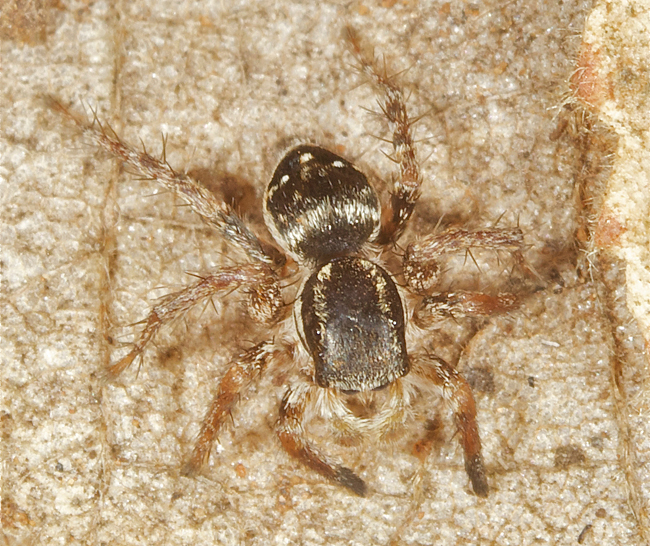
Kruger NP by ExFmem
Diagnosis
Small to medium spiders, ranging in body length from 3.30 to 6.40 mm in males and 4.00 to 8.20 mm in females. Sexes similar in general body shape. Sexual dimorphism is poorly marked and can be seen in the following characters: males are usually smaller (on average, by some 20% of their body length) and brighter coloured.
Carapace. Rather high, with the posterior half of the thorax abruptly declining, almost vertical; densely covered with elongated recumbent scales making its colour pattern of two wide, white longitudinal stripes running along the ALE–PLE lines and two white marginal stripes; fovea present and situated between PLEs, but sometimes poorly seen because of the dense scale cover; in many species the anterior part of the eye field is covered with short erect bristles, or in some species (especially in the males) carapace bears dense, mane-like bunches of hairs, sometimes also occupying cheeks.
eyes. In three rows, with large black areas surrounding eyes; in most species, the anterior eye row is slightly wider in both sexes , but females of at least five species have the anterior and posterior eye rows equally wide; yet in one species the anterior eye row is narrower by 3–5% than the posterior one in S. guttiger (in both sexes)
Clypeus. Vertical, medium to high, ranging between 45–79% of the AME diameter in males and 42–60% in females; clypeal colourful coloration in many species of Stenaelurillus is diagnostic at the species level.
Endites. in all species of Stenaelurillus endites with pale yellow to white apices
Abdomen. Elongate; males with the large dorsal scutum occupying the proximal half/two-thirds of the dorsum, the scutum may be invisible under the dense scale cover; colour markings on dorsum simple, either consisting of paired and/or singular white spots or white longitudinal stripes, sometimes with no white colour pattern at all.
Legs. Subequally developed; male legs I are usually darker than those of females, being entirely dark brown/black or with dark brown/black Tb, Mt and Tr; tarsal claws narrow, with well-developed and numerous teeth: 7–20 teeth prolaterally and 5–19 retrolaterally. Leg formula: IV/III,II/I in both sexes, the third and fourth pairs of legs are always longer than the first and second pairs.
Leg spination. All legs with numerous spines, especially on Tb and Mt of legs III–IV; the spine patterns of legs I–II are similar/identical, as are those of legs III–IV.
A complete detailed description of Stenaelurillus can be found here*

Kruger NP by ExFmem
Distribution
The geographical distribution of Stenaelurillus is clearly palaeotropical, covering almost the entire African continent, except for the western half of the equatorial zone, and then extending to southern Iran, south and SE Asia, including the southern and south-eastern territories of China. There are no common species between the Afrotropical and Oriental regions.
*https://www.researchgate.net/publicatio ... Salticidae
Family: Salticidae Subfamily: Salticinae Tribe: Aelurillini Subtribe: Aelurillina
Genus Stenaelurillus (SIMON, 1886)
Stenaelurillus is a diverse genus of jumping spiders, currently consisting of 45 valid species. Despite the availability of two relatively recent taxonomic surveys of the genus (Wesołowska 2014a, 2014b), many species still remain poorly diagnosed.



Kruger NP by ExFmem
Diagnosis
Small to medium spiders, ranging in body length from 3.30 to 6.40 mm in males and 4.00 to 8.20 mm in females. Sexes similar in general body shape. Sexual dimorphism is poorly marked and can be seen in the following characters: males are usually smaller (on average, by some 20% of their body length) and brighter coloured.
Carapace. Rather high, with the posterior half of the thorax abruptly declining, almost vertical; densely covered with elongated recumbent scales making its colour pattern of two wide, white longitudinal stripes running along the ALE–PLE lines and two white marginal stripes; fovea present and situated between PLEs, but sometimes poorly seen because of the dense scale cover; in many species the anterior part of the eye field is covered with short erect bristles, or in some species (especially in the males) carapace bears dense, mane-like bunches of hairs, sometimes also occupying cheeks.
eyes. In three rows, with large black areas surrounding eyes; in most species, the anterior eye row is slightly wider in both sexes , but females of at least five species have the anterior and posterior eye rows equally wide; yet in one species the anterior eye row is narrower by 3–5% than the posterior one in S. guttiger (in both sexes)
Clypeus. Vertical, medium to high, ranging between 45–79% of the AME diameter in males and 42–60% in females; clypeal colourful coloration in many species of Stenaelurillus is diagnostic at the species level.
Endites. in all species of Stenaelurillus endites with pale yellow to white apices
Abdomen. Elongate; males with the large dorsal scutum occupying the proximal half/two-thirds of the dorsum, the scutum may be invisible under the dense scale cover; colour markings on dorsum simple, either consisting of paired and/or singular white spots or white longitudinal stripes, sometimes with no white colour pattern at all.
Legs. Subequally developed; male legs I are usually darker than those of females, being entirely dark brown/black or with dark brown/black Tb, Mt and Tr; tarsal claws narrow, with well-developed and numerous teeth: 7–20 teeth prolaterally and 5–19 retrolaterally. Leg formula: IV/III,II/I in both sexes, the third and fourth pairs of legs are always longer than the first and second pairs.
Leg spination. All legs with numerous spines, especially on Tb and Mt of legs III–IV; the spine patterns of legs I–II are similar/identical, as are those of legs III–IV.
A complete detailed description of Stenaelurillus can be found here*

Kruger NP by ExFmem
Distribution
The geographical distribution of Stenaelurillus is clearly palaeotropical, covering almost the entire African continent, except for the western half of the equatorial zone, and then extending to southern Iran, south and SE Asia, including the southern and south-eastern territories of China. There are no common species between the Afrotropical and Oriental regions.
*https://www.researchgate.net/publicatio ... Salticidae
-
Klipspringer
- Global Moderator
- Posts: 5858
- Joined: Sat Sep 14, 2013 12:34 pm
- Country: Germany
- Contact:
Re: AW Arachnid Book: Spiders (Araneae) - Photos & Descriptions
Bark Crab Spider Tmarus sp.
Family Thomisidae
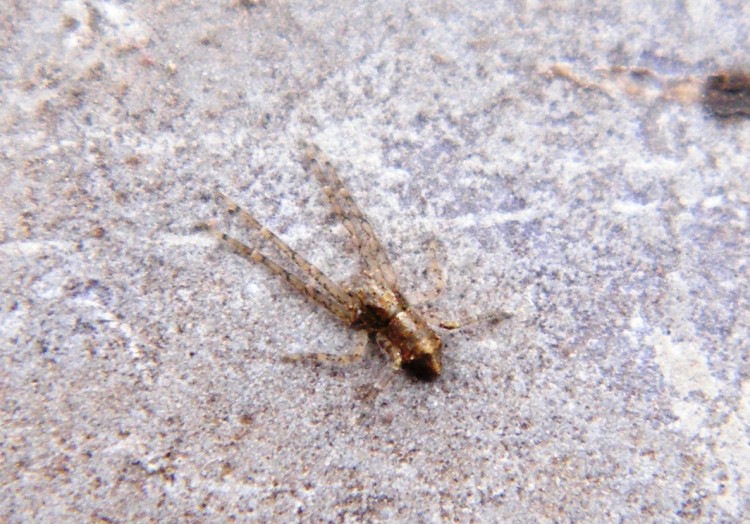 © Richprins
© Richprins
Marloth Park, Mpumalanga
The members of Tmarus are small to medium-sized spiders, characterized by the shape of the carapace and abdomen. The abdomen often has a tubercle caudodorsally which resembles a leafbud or scar. They live mainly on plants and rest with their bodies and legs pressed against the substratum. Their mottled dull grey and brown bodies camouflage' them so well that they are almost indistinguishable against their background.
Size: females 3,7-7,3 mm), males are slightly smaller than females (3,6-5,8 mm).
Colour: Cream to dull grey, mottled with cream, brown or black.
Carapace: as wide as long, rather convex, declines abruptly towards posterior border; clothed with numerous strong primary setae; clypeus porrect; ocular area well elevated, lateral eyes situated on well-defined tubercles; posterior tubercle the largest; both eye rows almost straight or only slightly recurved; lateral eyes larger than median eyes; AME smallest.
Abdomen dorsally often with posterior tubercle or other modification; clothed with numerous short stiff setae, which are sometimes situated on small tubercles.
Legs spinous; I and II almost same length, longer than III and IV.
Links:
https://journals.co.za/docserver/fullte ... 731BA50F2B
Family Thomisidae
Marloth Park, Mpumalanga
The members of Tmarus are small to medium-sized spiders, characterized by the shape of the carapace and abdomen. The abdomen often has a tubercle caudodorsally which resembles a leafbud or scar. They live mainly on plants and rest with their bodies and legs pressed against the substratum. Their mottled dull grey and brown bodies camouflage' them so well that they are almost indistinguishable against their background.
Size: females 3,7-7,3 mm), males are slightly smaller than females (3,6-5,8 mm).
Colour: Cream to dull grey, mottled with cream, brown or black.
Carapace: as wide as long, rather convex, declines abruptly towards posterior border; clothed with numerous strong primary setae; clypeus porrect; ocular area well elevated, lateral eyes situated on well-defined tubercles; posterior tubercle the largest; both eye rows almost straight or only slightly recurved; lateral eyes larger than median eyes; AME smallest.
Abdomen dorsally often with posterior tubercle or other modification; clothed with numerous short stiff setae, which are sometimes situated on small tubercles.
Legs spinous; I and II almost same length, longer than III and IV.
Links:
https://journals.co.za/docserver/fullte ... 731BA50F2B
-
Klipspringer
- Global Moderator
- Posts: 5858
- Joined: Sat Sep 14, 2013 12:34 pm
- Country: Germany
- Contact:
Re: AW Arachnid Book: Spiders (Araneae) - Photos & Descriptions
Wall Crab Spider Selenops sp.
Family Selenopidae
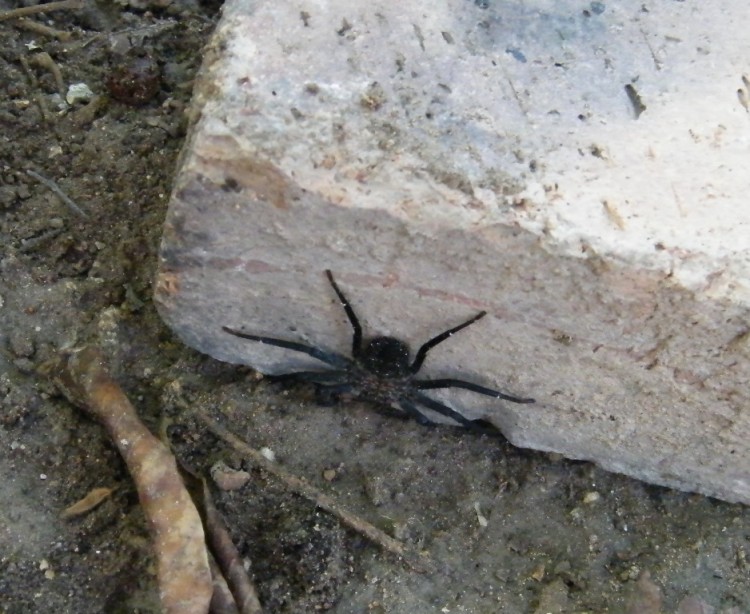 © Richprins
© Richprins
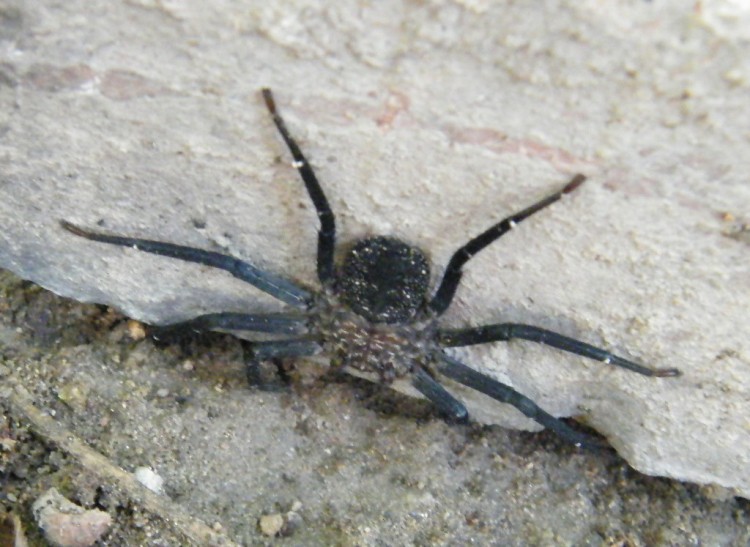 © Richprins
© Richprins
Kruger National Park, Berg en Dal
Selenops has a subtropical distribution occurring in central and south America, Asia, Africa, Mediterranean region of southern Europe. There are 12 species known from South Africa.
Selenops differ from other selenopid genera in the arrangement of the eyes. The anterior median eyes, posterior median eyes and anterior lateral eyes align or are slightly recurved. They are brown to reddish brown spiders with dark spots.
Family Selenopidae
Kruger National Park, Berg en Dal
Selenops has a subtropical distribution occurring in central and south America, Asia, Africa, Mediterranean region of southern Europe. There are 12 species known from South Africa.
Selenops differ from other selenopid genera in the arrangement of the eyes. The anterior median eyes, posterior median eyes and anterior lateral eyes align or are slightly recurved. They are brown to reddish brown spiders with dark spots.
-
Klipspringer
- Global Moderator
- Posts: 5858
- Joined: Sat Sep 14, 2013 12:34 pm
- Country: Germany
- Contact:
Re: AW Arachnid Book: Spiders (Araneae) - Photos & Descriptions
Heart-shaped Wolf Spider Zenonina albocaudata
Family Lycosidae

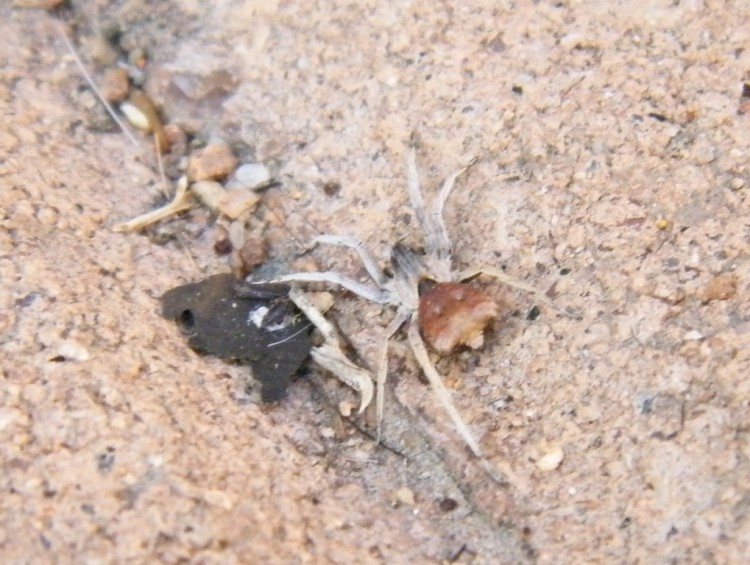 © Richprins
© Richprins
Nelspruit
Genus Zenonina
Members of this genus are recognised by the different shape of the carapace and abdomen. They lack the typical lycosid bands on the carapace and abdomen. The carapace is round with the eye region narrowed and bearing strong setae. On the thoracic region the carapace has a strong indentation where the abdomen fits in. The abdomen has a triangular shape. The legs are strong and the femur and tibiae of the front legs bear strong setae.
Description Zenonina albocaudata
Size: TL female 6-7 mm, male 5-6 mm. Carapace is cream without bands; anterior eye region is infused with black; posterior declivity of carapace is dark; narrow white line around edge.
Abdomen is very distinctive, truncated, heart-shaped, dark grey, white spot above spinnerets. Legs are cream without markings.
Family Lycosidae
Nelspruit
Genus Zenonina
Members of this genus are recognised by the different shape of the carapace and abdomen. They lack the typical lycosid bands on the carapace and abdomen. The carapace is round with the eye region narrowed and bearing strong setae. On the thoracic region the carapace has a strong indentation where the abdomen fits in. The abdomen has a triangular shape. The legs are strong and the femur and tibiae of the front legs bear strong setae.
Description Zenonina albocaudata
Size: TL female 6-7 mm, male 5-6 mm. Carapace is cream without bands; anterior eye region is infused with black; posterior declivity of carapace is dark; narrow white line around edge.
Abdomen is very distinctive, truncated, heart-shaped, dark grey, white spot above spinnerets. Legs are cream without markings.
-
Klipspringer
- Global Moderator
- Posts: 5858
- Joined: Sat Sep 14, 2013 12:34 pm
- Country: Germany
- Contact:
Re: AW Arachnid Book: Spiders (Araneae) - Photos & Descriptions
Wall Crab Spider
Family Selenopidae
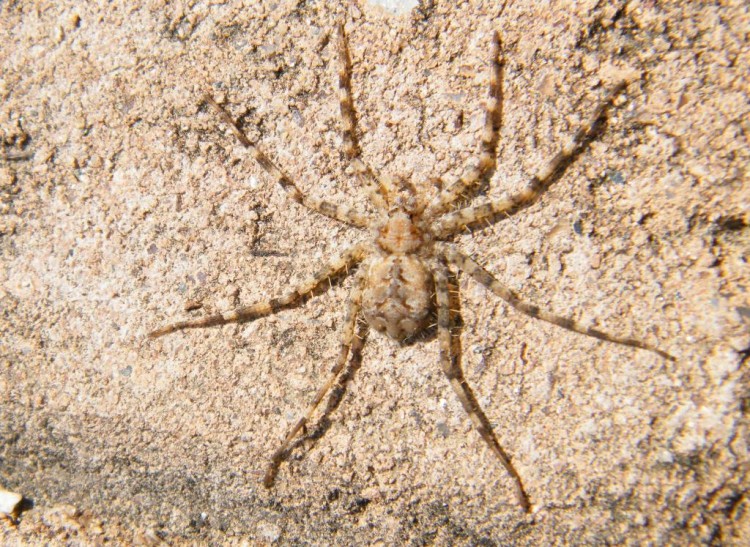 © Richprins
© Richprins
Nelspruit
Family Selenopidae
Nelspruit
-
Klipspringer
- Global Moderator
- Posts: 5858
- Joined: Sat Sep 14, 2013 12:34 pm
- Country: Germany
- Contact:
Re: AW Arachnid Book: Spiders (Araneae) - Photos & Descriptions
Flower Crab Spider Thomisus sp.
Family Thomisidae
© steamtrainfan
Family Thomisidae
© steamtrainfan
-
Klipspringer
- Global Moderator
- Posts: 5858
- Joined: Sat Sep 14, 2013 12:34 pm
- Country: Germany
- Contact:
Re: AW Arachnid Book: Spiders (Araneae) - Photos & Descriptions
The Oxypidae are maInly plant living spiders commonly found on grasses, shrubs and trees. Oxypoids are also known as lynx spiders because of the way in which they hunt their prey. They are active diurnal hunters, moving around on the plant, leaping from leaf to leaf. They detect their prey easily by means of their sharp eyesight and then chase their prey and jump on it. They have been observed jumping in the air to catch their prey. When at rest, they lie flat against the leaf.
The dependence of oxyopids on their good eyesight is also reflected in their courtship behaviour, where visual signals initiate courtship behaviour. The male and female can detect each other from a distance of several centimetres. The male waves his darkly coloured palp in front of the female.
The family Oxyopidae is a well-defined group of small to moderately large spiders. They can be distinguished from other families by the hexagonal arrangement of their eyes, as the posterior row is slightly procurved, and the anterior row strongly recurved.
KEY TO THE GENERA OF OXYPIDAE FROM THE AFROTROEICAL REGION
1. Chelicera devoid of teeth; ALE row distinctly wider than PME row; posterior eye row only slightly procurved. Bright green. . . . . . . . . . . . . . . . . . . . . . . . Peucetia
- Chelicera with a single tooth; ALE row subecjual to PME row or PME row much wider than ALE row; posterior eye row strongly procurved. Not green . . . . . . 2
2. Distance between FME subegual to distance between EME and PLE . . . . . . . . . . . . . . . . . . . . . . . . . . . . . . . . . . . . . . . . . . . . . . . . . . . .. . . . . . . . . . Oxyopes
- Distance between EME much greater than distance from PME to PLE . . . . . . . . . . . . . . . . . . . . . . . . . . . . . . . . . . . . . . . . . . . . . . . . . . . . . . . . . . . . Hamataliwa
Genus Peucetia - Green Lynx Spiders
The members of Peucetia with their bright green colour are usually found on the green foliage of shrubs and trees and mimic the colour of their hosts. The genus Peucetia includes a group of spiders characterized by their large size and bright green colour.
Sizes range in females 10-22 mm; 8-18 mm in males.
The carapace is longer than wide, high and convex anteriorly, sloping posteriorly.
The eyes are black.
The clypeus, which can only be seen from the front, sports lines which are of diagnotic importance. The clypeal lines vary in colour from red to black. There may be two or four clypeal lines.
The legs are long and slender, covered with long spines, except the coxa, trochanter and tarsus which has no spines but many setae. The spines and setae on the legs are usually surrounded by dark-brown or black spots or large marks which provide the characteristic spotted appearance to the legs of most Peucetia spp.
The abdomen is elongate, qradually tapering posteriorly, becomes ovoid during egg production. The abdominal dorsum is mainly green with markings varying between species. Usually the dorsum has a mediolongitudinal area which is bordered by pale lines. These lines may also be composed of white spots which run into one another. The mediolongitudinal area may be plain or composed of chevron patterns, triangular marks or obliquely placed markings. A dark green sword-like, cross-shaped or branched mark (= cardiac mark) in the cardiac region of the dorsum is always present. The exact size and shape of the cardiac mark is variable.
Diagnosis: The chelicerae are devoid of teeth. The eye group is hexagonal and the ALE form a row distinctly wider than that formed by the PME. The posterior eye row is only slightly procurved. The legs are long and slender, clothed in numerous long erect spines.
Links:
https://www.biodiversityexplorer.info/a ... ucetia.htm
https://ujcontent.uj.ac.za/vital/access ... 4/CONTENT1
The dependence of oxyopids on their good eyesight is also reflected in their courtship behaviour, where visual signals initiate courtship behaviour. The male and female can detect each other from a distance of several centimetres. The male waves his darkly coloured palp in front of the female.
The family Oxyopidae is a well-defined group of small to moderately large spiders. They can be distinguished from other families by the hexagonal arrangement of their eyes, as the posterior row is slightly procurved, and the anterior row strongly recurved.
KEY TO THE GENERA OF OXYPIDAE FROM THE AFROTROEICAL REGION
1. Chelicera devoid of teeth; ALE row distinctly wider than PME row; posterior eye row only slightly procurved. Bright green. . . . . . . . . . . . . . . . . . . . . . . . Peucetia
- Chelicera with a single tooth; ALE row subecjual to PME row or PME row much wider than ALE row; posterior eye row strongly procurved. Not green . . . . . . 2
2. Distance between FME subegual to distance between EME and PLE . . . . . . . . . . . . . . . . . . . . . . . . . . . . . . . . . . . . . . . . . . . . . . . . . . . .. . . . . . . . . . Oxyopes
- Distance between EME much greater than distance from PME to PLE . . . . . . . . . . . . . . . . . . . . . . . . . . . . . . . . . . . . . . . . . . . . . . . . . . . . . . . . . . . . Hamataliwa
Genus Peucetia - Green Lynx Spiders
The members of Peucetia with their bright green colour are usually found on the green foliage of shrubs and trees and mimic the colour of their hosts. The genus Peucetia includes a group of spiders characterized by their large size and bright green colour.
Sizes range in females 10-22 mm; 8-18 mm in males.
The carapace is longer than wide, high and convex anteriorly, sloping posteriorly.
The eyes are black.
The clypeus, which can only be seen from the front, sports lines which are of diagnotic importance. The clypeal lines vary in colour from red to black. There may be two or four clypeal lines.
The legs are long and slender, covered with long spines, except the coxa, trochanter and tarsus which has no spines but many setae. The spines and setae on the legs are usually surrounded by dark-brown or black spots or large marks which provide the characteristic spotted appearance to the legs of most Peucetia spp.
The abdomen is elongate, qradually tapering posteriorly, becomes ovoid during egg production. The abdominal dorsum is mainly green with markings varying between species. Usually the dorsum has a mediolongitudinal area which is bordered by pale lines. These lines may also be composed of white spots which run into one another. The mediolongitudinal area may be plain or composed of chevron patterns, triangular marks or obliquely placed markings. A dark green sword-like, cross-shaped or branched mark (= cardiac mark) in the cardiac region of the dorsum is always present. The exact size and shape of the cardiac mark is variable.
Diagnosis: The chelicerae are devoid of teeth. The eye group is hexagonal and the ALE form a row distinctly wider than that formed by the PME. The posterior eye row is only slightly procurved. The legs are long and slender, clothed in numerous long erect spines.
Links:
https://www.biodiversityexplorer.info/a ... ucetia.htm
https://ujcontent.uj.ac.za/vital/access ... 4/CONTENT1


